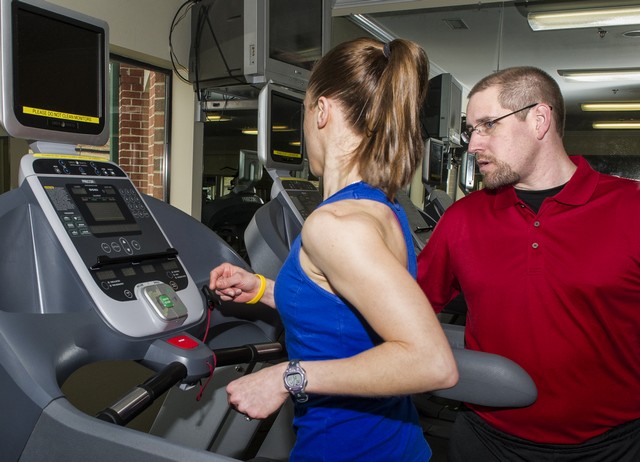According to the American College of Sports Medicine (ACSM), cardiorespiratory(CR) fitness, measured by VO2, is directly related to the body’s ability to perform and sustain moderate-to-high impact large muscle movement exercises. Volume of Oxygen Consumption (VO2) is the measure of the amount of oxygen (in milliliters of oxygen per kilogram of body weight per minute (ml/kg/min)) that is inspired and utilized during various levels of work. MaxVO2 is the amount of Oxygen consumed during the athletes Maximum work load. Knowing the VO2 range between rest and maximal work capacity is a vital part of determining the target workload for a client on a given type of work such as cycling or running. An athlete with a VO2Max of 50ml/kg/min would enjoy a higher impact workout than a person with a VO2Max of 30ml/kg/min.
We can determine the athletes VO2 through several testing modalities such as the Bruce Protocol Graded Exercise Test (GXT). The Bruce Protocol is performed on the treadmill where the speed and incline are increased at to specified levels at 3-minute intervals. The test is terminated when the athlete has reached exhaustion giving us their maximum heart rate and maximum work load.
The testing trainer will take the top speed and percent grade of the treadmill to determine the athlete’s relative VO2Max. With this number we can determine absolute VO2Max, METs, maximum caloric cost of work completed and more. A percentage of the VO2Max is used to establish the athletes training intensity, and amount of time spent in each workout.
Improving your VO2 comes with increasing endurance training volume and intensity gradually over time. For the runner the increase would come by adding time or mileage to their weekly run volume. The most efficient ways to improve VO2Max include large muscle rhythmic movements such as running, cycling, swimming, and rowing. Aerobic classes can also show improvements in VO2 however are not always as efficient as the more constant motions. It is important to note that since VO2 is a measure of aerobic capacity (the amount of oxygen the body is able to use,) strength and power training would have minimal to no significant effect on VO2Max.
ACSM tells us that endurance training and High Intensity Interval Training(HIIT) can help to maintain or improve CR fitness. HIIT Training is a balance between short bouts of vigorous exercise coupled with short rest periods. An example of HITT training would be:
Warm up for 10 minutes prior to beginning the HIIT Program followed by a brief pre-stretch.
Next, repeat these 8 exercises 2-4 times for a total of 8-16 minutes of vigorous activity
30 seconds Plank
15 seconds Rest
30 seconds Push Ups
15 seconds Rest
30 seconds Sit Ups
15 seconds Rest
30 seconds Mountain Climbers
15 seconds Rest
30 seconds Side Plank
15 seconds Rest
30 seconds Back Bridge Marches
15 seconds Rest
30 seconds Lateral Hops
15 seconds Rest
30 seconds Jump Squats
15 seconds Rest
Cool Down with a light 10 minute jog followed by a thorough head to toe stretch to round out the workout. Modify the workout intensity to fit your current CR fitness. If you are unsure of what your current VO2Max is, a certified Health Fitness Specialist can select the appropriate GXT or field test to fit your needs.
Sources: American College of Sports Medicine,
American Council on Exercise,
Exercise Prescription EXRX.net








